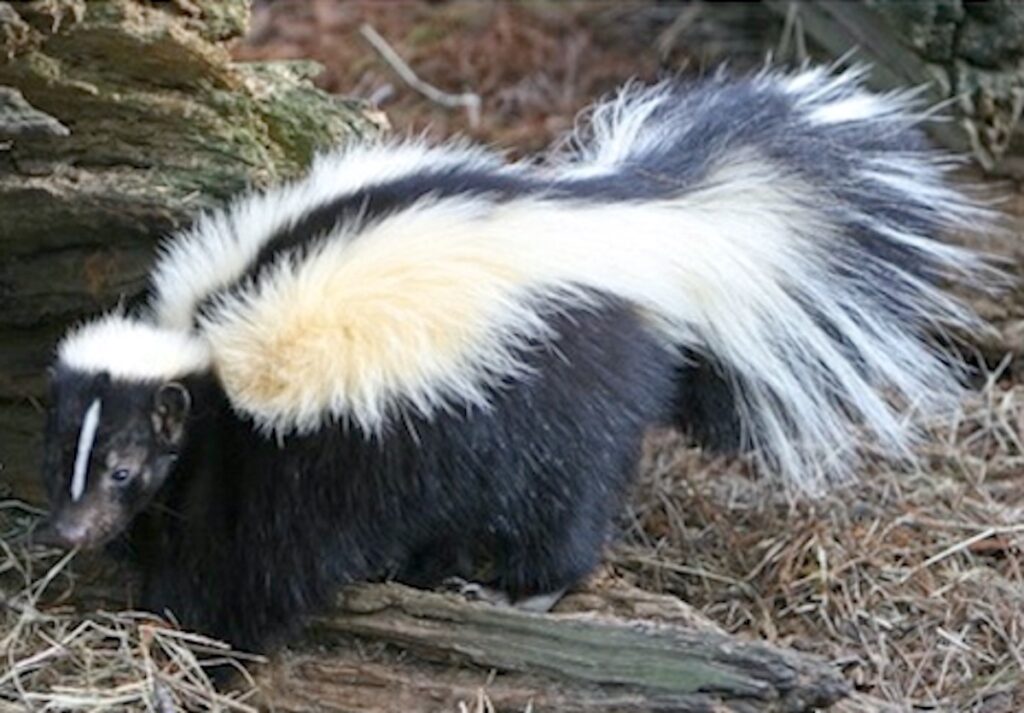“Skunk!” I slammed on the brakes and pulled to the side of the road. Before my brain was properly functioning, I was out of the truck and running toward the animal. I just wanted a closer look.
Suddenly it saw me coming, turned his bottom toward me, and I could see the hairs on his back end and tail standing erect. My brain finally catching up to my legs, I stopped on a dime and started backpedalling. He thankfully never sprayed, because he didn’t have to.
I already knew what to expect, and that deterrence is part of the beauty of skunks. They will spray their odiferous scent on potential predators, but most of the time they don’t have to. Most predators have already figured it out.

We usually notice skunks as roadkill, because they are typically very secretive and nocturnal, moving only at night. Skunks get hit by cars at this time of year because males are on the move looking for females, and the mix of spending more time moving and being too focused on mating is a deadly combination on roads, for both skunks and humans.
You cannot blame the skunks for doing what evolution compels them to do, and eventually we can only hope that smarter, perhaps more agile male skunks will be selected over time.
Until that happens, we can expect skunks on the road for the foreseeable future. This time of year just seems to be skunk season, and their pungent smell reminds us that love is in the air, and the skunks are out and about trying to make more skunks.
Skunks are closely related to weasels and were once thought to be members of the weasel family, but now are classified into their own skunk family.
However, skunks are similar to one weasel (the wolverine) in stature, with a small head, small ears and eyes, a pointed snout, short legs, and a broad rear. Like wolverines, the front claws are long and sharp and adapted for digging, both for food and to create dens.
All weasels have prominent musk glands, but only skunks can spray their musk in self-defense. Because of this, they also differ from the subtle coloration of most mammals with their obvious white on black fur, which they use to advertise their defense mechanism.
Although most similar-sized mammals will flee when approached by a predator, skunks stand their ground, knowing their defense is more than enough to repel any attack.
When it is time to spray, skunks aim their posterior, and the stream of scent shoots from two ducts that protrude through the anus, which is accurate up to 15 feet.
Many of us have smelled this scent, which is nauseating and can also cause temporary blindness. Tomato juice baths are a good remedy to reduce the stench in both dogs and humans.
There are five skunk species in North America, of which two live in our region. Striped skunks are about two feet long and weigh 3-12 pounds, with males slightly larger than females, and are black with a white patch on the head that forks into two long stripes along the back and tail. Striped skunks feed heavily on insects in the summer, including digging out bumblebee and hornet colonies.
Sometimes they leave small cone-shaped holes in the soil where they have dug up grubs. They also feed on a variety of other insects, small mammals, amphibians, bird eggs, and fruits. They den in burrows, sometimes below houses and other times taking over woodchuck homes.
Striped skunks mate in mid-February to mid-April, coinciding with an increase in vehicle collisions. Females produce four to eight young, called kits, which are born naked and helpless. However, eight days after birth they are able to deliver their pungent musk. They nurse for six to eight weeks and then follow their mother out of the den on nightly hunting trips for the next few months.
Great-horned owls are one of most successful predators of skunks, perhaps because they lack a well-developed sense of smell. I imagine those bright white stripes ambling along the forest floor must look like an easy meal for the nocturnally-adapted owls. Bobcats, coyotes, and foxes also occasionally kill skunks, even with their smelly defense. Striped skunks typically live an average of two to four years in the wild; captive individuals have survived for a decade.
Spotted skunks are the smaller and more secretive skunk species. Rather than two continuous stripes, spotted skunks have four broken white stripes along the neck, back, and sides.
Spotted skunks are more agile than striped skunks, and catch more small mammals like mice, voles, and young rabbits. They also climb trees, unlike their striped cousins.
Even more unusual, spotted skunks often do a handstand when confronted by predators, hoisting their fluffy tail above them to make it even more obvious. If a predator advances, they drop to all four and twist into a U-shape, rear and face directed toward the danger, ready to spray.
Spotted skunks are of conservation concern in many states because of their low populations, which may be due to changes in farming practices and pesticide use, but more research is needed to understand why this species has become less common in recent years.
We may hate the smell of skunks on the highway, and no one wants to have a skunk living under their house, because you never know when that scent bomb might go off. Yet you have to admire their amazing defense strategy, and this time of year, that smell reminds me that this secretive species is getting ready to mate, just in time for Valentine’s Day.
Indeed, skunk season is as good of an indicator of the holiday as is the appearance of valentine chocolates and flowers in our stores.
The smell of love is in the air, even if it burns the nostrils.
This story first ran in the Northern Kentucky Tribune, a nonprofit publication of the Kentucky Center for Public Service Journalism.
Dr. Howard Whiteman is a professor in the Department of Biological Sciences at Murray State University and holds the Commonwealth Endowed Chair of Environmental Studies.






